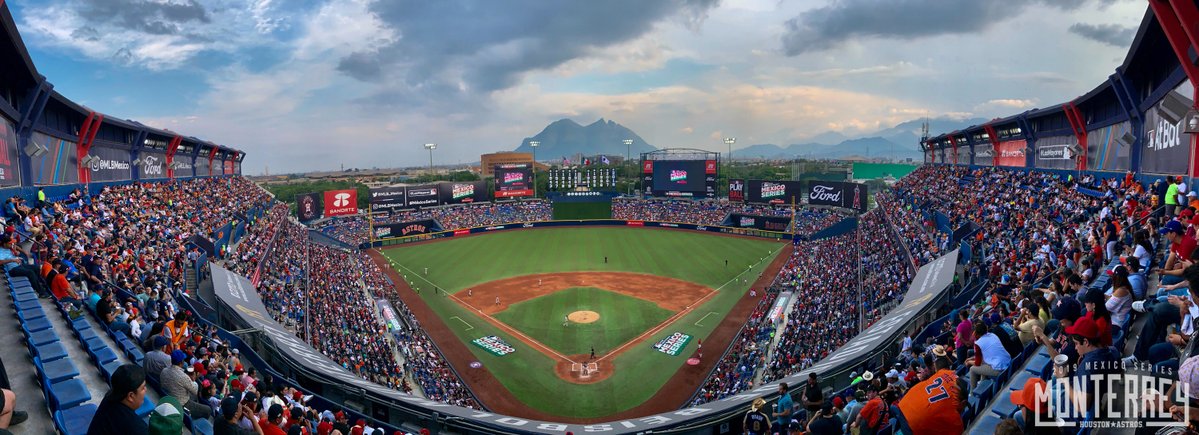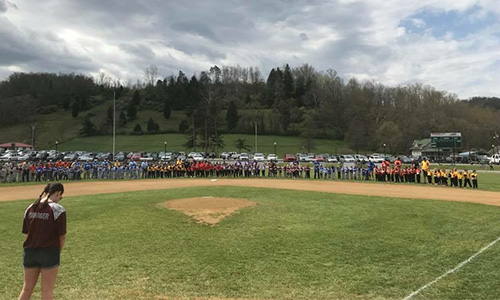
A Salute to Cinco de Mayo -- And the International Game
@Reds @Cardinals @peloteros_MLB @MLB_PLAYERS @MLB @LigaMexBeis @MiLB @WBSC @WBSCPresident @Baseball @WBSCsoftball @WBSC_AMERICAS @USABaseball_ESP #CaseyattheBat #CaseyalBate #BorntoBaseball
My wife suggested last week that the occasion of Cinco de Mayo afforded an excellent opportunity to post a blog about Mexican baseball and the excitement of international baseball competition. You see, we had watched the Cincinnati Reds ("Los Rojos") and the St. Louis Cardinals ("Los Cardenales") play their two-game series at the beautiful Estádio de Béisbol Monterrey (the largest baseball stadium in Mexico), as part of a three-series, six-game contest bringing National and American League teams to Mexico. As it turns out, this program is part of a larger effort by Major League Baseball and the Major League Baseball Players Association to promote the international character of the game. And also, we thought, this was another great opportunity to celebrate the relationship between two neighbors--Mexico and the United States--which drives the popularity of the annual Cinco de Mayo festivities throughout North America.

Estadio de Béisbol, Monterrey home of Sultanes de Monterrey
The Colorado Rockies and the Arizona Diamondbacks had already played a pair of Spring Training games in Monterrey on March 9-10; and as I write this, the Los Angeles Angels and the Houston Astros are playing a two-game series, further establishing the Cinco de Mayo connection.
There was plenty of local excitement for the series both in Cincinnati and St. Louis, with many reminders of the personal ties that join the two North American countries. Cincinnati Reds bench coach Freddie Benavides brought twenty family members to the game--some of his wife's relatives are from Reynosa, in Mexico, and Benavides' paternal grandmother was originally from Monterrey. Also, Cardinals reliever Giovanny Gallegos is from Mexico and had represented his country in the 2017 World Baseball Classic.
Baseball has a long and colorful history in Mexico, with evidence dating from the 1860's of Mexican students who had studied in Santa Clara, California bringing the game back to Mexico with them. The Union Base Ball Club was founded around 1869 in Matamoros, crossing the Rio Bravo to play Texas teams in Brownsville. The first Mexican citizen to play in MLB was Baldomero "Melo" Almada, who debuted with the Boston Red Sox on September 8, 1933. Since then, many Mexican nationals have played on MLB teams. And Americans have played on Liga Mexicana teams! During the 1930's and 1940's, before Jackie Robinson broke the U.S. color barrier in 1947, African-American players from the U.S. played together with Mexicans and Cubans in the Liga Mexicana. Satchel Paige, James "Cool Papa" Bell, and Josh Gibson were some of the stars of the Liga Mexicana in that era.

Héctor Espino (1939-1997), one of the greatest sluggers of all time. Born in Chihuahua, Espino played in the Liga Mexicana from 1960 to 1984, hitting between 755 and 796 home runs
Currently 16 teams in the Liga Mexicana de Béisbol are divided into two divisions, North and South, competing in a 7-game summer championship series between the division winners. The level of play is at the AAA minor-league level. In the winter, eight teams play in a Liga Mexicana del Pacifico, the winner advancing to play a Caribbean series against other Latin American winners.

Spalding World Baseball Tour, 1888-89, at the Villa Borghese in Rome
Baseball is already an international game and is becoming a universal game, realizing in the 21st century the dream of Al Spalding (1849-1915), star player, baseball promoter, and entrepreneur who in 1888-1889 took two all-star teams of American players in a tour around the world. Baseball became an official Olympic sport at the 1992 Summer Olympics although it had been played unofficially at the games since 1904. After 2008, the sport was dropped from the Summer Olympics but will be revived for the 2020 summer games in Tokyo. In 2019, the Pan American Games baseball tournament will be held in Lima, Peru from July 27 to August 4, with eight teams competing, including those representing Argentina, Canada, Colombia, Cuba, Dominican Republic, Nicaragua, Peru, and Puerto Rico.
And another exciting international competition in 2019 will take place at the Women's Softball World Cup in Irvine, California, August 11-17. Teams will take the field from all five Olympic continents, including the countries of South Africa, Botswana, U.S., Canada, Puerto Rico, Mexico, Brazil, Japan, Chinese Taipei, China, Italy, the Netherlands, Czech Republic, Ireland, Australia, and New Zealand.
An incomplete list of countries in which baseball has become a popular (or professional league) sport includes Argentina, Australia, Canada, South Korea, Cuba, Italy, Japan, Nicaragua, the Netherlands, Sweden, Panama, the United States / Puerto Rico, the Dominican Republic, South Africa, Chinese Taipei, Venezuela, and Colombia--in addition to Mexico of course.
And because this is a blog not only about baseball, but principally about baseball's legendary ballad, it occurred to me that "Casey at the Bat," with its universal themes and heroic protagonist facing fearful odds, also deserves to be as universally appreciated as the game of baseball it portrays.
Caseyatthe.blog would like to see "Casey at the Bat" translated, in poetic format, into all the languages of the nations in which the game is played--including Italian, Dutch, Mandarin Chinese (and other recognized languages in Taiwan / Chinese Taipei), Korean, Swedish, Portuguese, Czech, and Japanese. For the moment, though, to celebrate the #MexicoSeries we will soon offer a new, and perhaps the only, complete and versified translation of "Casey at the Bat" into Spanish. Stay tuned for "Casey al Bate!"

Illustration from "Casey at the Bat," 1912 edition, by artist Dan Sayre Groesbeck
Cover Photo: Fans pack the beautiful #EstadioMonterrey for the 2019 #MexicoSeries between @astros and @AngelsBeisbol !
Thanks to "Baseball Historian" ( www.baseballhistorian.com ) as a source of historical information on Mexican baseball, and to Eric Nusbaum, for his article on Héctor Espino, "The Unknown Slugger," in www.sbnation.com , May 21, 2013.
@SBNation @sabr @OnlyAGameNPR @klgiven @MartinKessler91 @BaseballBrit @NCAACWS @mexbaseball @BaseballAmerica @USABaseball_ESP @USABaseball @TigresdeDetroit @DiablosRojosMX @tigresqroficial @Pericos_Oficial @AcererosOficial @GuerrerosOax @OficialSarapero @RielerosDeAgs @AlgodonerosUL @LeonesOficial @SultanesOficial @TorosDeTijuana @PiratasCampeche @NacimosBravos @OlmecasTabasco @GeneralesdDgo @Broncos_Rey @ahbeisbol @USASoftball @ESFsoftball @SoftballCanada @SoftballOz @Czechsoftball @Padres @TinCaps @RedSox @PawSox @LaVidaBaseball @MLBPAA @baseballhall


Leave a comment
This site is protected by hCaptcha and the hCaptcha Privacy Policy and Terms of Service apply.